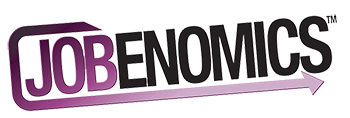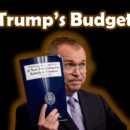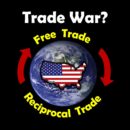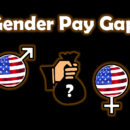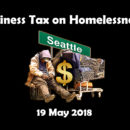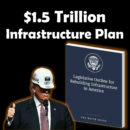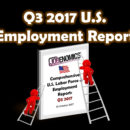Trump Administration’s Minimum Wage Conundrum
President Trump’s New Economy Challenge (Part 17 of 20). Most people perceive that minimum wage laws apply mainly to the 4.7 million fast-food industry workers. This perception understates the serious consequences of a universal minimum wage to all businesses, the labor force and the U.S. economy. If a $15/hour minimum wage was implemented today nation-wide for all able-bodied Americans who can work, 159 million citizens would qualify for the minimum wage threshold according to U.S. Census Bureau wage and earnings data. 44 million Americans in the top 50 projected highest growth occupations listed in the Bureau of Labor Statistics’ Occupational Outlook Handbook would also need an hourly increase in pay of up to $6 per hour to meet the threshold. According to the Handbook, even 22 out of the 36 (61%) top non-college degree occupations make below minimum wage.
In a Bloomberg interview with Mary Kay Henry, the President of the Service Employees International Union (SEIU, an organization of 2 million unionized service workers), Ms. Henry stated that a $15 minimum wage would be a boon to small businesses since workers would have more money in their pockets to spend. Jobenomics agrees with this statement. Jobenomics also agrees with SEIU’s recommendation to provide “job ladders and training” for low-wage earners to escape poverty. Per Ms. Henry, “We now have 10 million workers on a path to $15 in New York and California. It will be fascinating how transformative those dollars are to economic growth in those communities.”
Jobenomics believes that the New York and California minimum wage efforts will be fascinating indeed, especially on the impact on small businesses. Hopefully, minimum wage efforts will succeed without crippling small businesses.
- According to California Governor Jerry Brown, California’s new minimum wage law will increase the wage for about 6.5 million California residents which equates for a pay increase for 43% of the state’s private sector workforce.
- New York’s minimum wage will lift the earnings of more than 2.3 million New Yorkers (29% of the state’s private sector workforce) plus a 12 week paid family leave policy. According to Governor Andrew Cuomo, these policies will show the nation that New York is leading “the way forward on economic justice.” Businesses in the New York metropolitan area that have high costs of living are likely to easily absorb $15/hour, but smaller cities and rural areas with lower costs of living may not find it so easy. The New York minimum wage schedule for New York City is focused on “large business”, which New York defines as businesses with a least 11 employees (employers with 11 employees are considered micro businesses by Jobenomics) and will start $11 an hour in 2017 and increase to $15 by 2019. For workers outside the NYC metro, minimum wage would start at $9.70 in 2017, grow to $12.50 in 2021 and continue to increase to $15 based on an “indexed schedule” determined by the State.
Rather than instituting a universal minimum wage, Jobenomics prefers workforce incentives and supplements that would encourage citizens—115 million below average wage earners, 15 million unemployed and underemployed workers, 16 million new workforce entrants per year and 95 million sidelined adults capable of working but choose not to work —to join the U.S. labor force. Incentives and supplements would include programs like a livable minimum wage in proportion to the local cost of living, temporary exemptions for internships, and a transition period to allow welfare recipients to keep a portion of their benefits as they transition to workfare. In other words, rather than funding people not to work, subsidize them to work by providing ways to bridge the gap between low wages and livable wages.
Building welfare to workfare “bridges” is only the first step. The next step involves building career paths (ladders) via certified training programs designed to quickly advance people up the initial steps of the ladder. The final step is to mass-produce highly-scalable small businesses—the employer of the vast majority of Americans, low income wage earners, new workforce entrants and the formerly unemployed—to provide meaningful ownership and long-term career opportunities for those that start their journey at the bottom rung of the ladder.
Stay tuned for the next installment in the President Trump’s New Economy Challenge series entitled, “The Urban Renewal Imperative” scheduled for release on 1 April 2017.
Click to read the rest of the articles in a 20-part series on President Trump’s New Economy Challenge. Note: many series articles require a small ($5) subscription fee. Non-series articles and Jobenomics project reports are free at Jobenomics.com. All subscription fees are directly (100%) applied to the Jobenomics Urban Renewal Programs. Donations to revitalizing blighted inner-cities are most welcome.
Jobenomics deals with economics of business and job creation. The non-partisan Jobenomics National Grassroots Movement’s goal is to facilitate an environment that will create 20 million net new middle-class U.S. jobs within a decade. The Movement has a following of an estimated 20 million people. The Jobenomics website contains numerous books and material on how to mass-produce small business and jobs. Monthly website traffic exceeds one-half million hits, which is indicative of the high level of public interest regarding economic, business, labor force and workfare solutions. For more information, see Jobenomics Overview and the Author’s Biography.
Recommended reading
- Casinos Not On Gamstop
- Casino Not On Gamstop
- Casino Non Aams
- UK Casinos Not On Gamstop
- Non Gamstop Casinos
- Non Gamstop Sports Betting Sites
- Online Casinos UK
- Non Gamstop Casino Sites UK
- Non Gamstop Casino Sites UK
- Non Gamstop Casino Sites UK
- Slots Not On Gamstop
- Non Gamstop Casino Sites UK
- Non Gamstop Casino Sites UK
- Non Gamstop UK Casinos
- Non Gamstop Casino Sites UK
- Top Casino Sites UK
- Best Casino Sites UK
- UK Casino Sites Not On Gamstop
- Meilleur Casino En Ligne
- Meilleur Casino En Ligne
- Gambling Sites Not On Gamstop
- Best Non Gamstop Casino
- UK Casino Sites Not On Gamstop
- Gambling Sites Not On Gamstop
- Crypto Casinos
- Jeux Casino En Ligne
- Meilleur Site Casino En Ligne Belgique
- I Migliori Casino Non Aams
- 코인카지노
- букмекерские конторы
- カジノ バカラ
